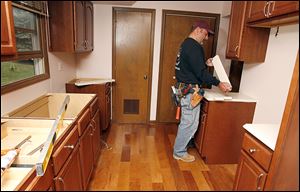
Fixer-uppers bring some risk
Number of homes flipped in Lucas County slowing down
6/3/2014
Kevin Krueger installs a countertop during a kitchen remodel in Naperville, Ill. RealtyTrac Inc. said the gross return on investment on flipped houses was 2.3 percent in the last year in Lucas County.
Investors might want to think twice before diving into house flipping in Lucas County.
A report released Monday by a major real estate data firm found there’s not much meat on the bone for real estate investors who buy homes, fix them up, and resell them.
During the last year, 141 homes in Lucas County were bought and resold within six months, according to the RealtyTrac Inc. report. On average, the gross return on investment was just 2.3 percent.
RealtyTrac said it looks only at the difference between purchase price and sales price, so the return doesn’t include money put into sprucing up or major renovations. The California-based company said data comes from public records.
House flipping has been trendy during the last few years, with several cable television shows dedicated to the subject. Even rapper Vanilla Ice has his own show on DIY Network.
It’s not just pop culture, though. Daren Blomquist, a vice president at RealtyTrac, said there was a flipping frenzy in 2012 and early 2013 as many markets bottomed out and home prices started rising.
“It was a perfect storm for investors to buy those properties low, fix them up, and sell them at a premium price,” he said.
Mr. Blomquist said the pace of home flipping slowed going into this year, as foreclosure rates have fallen and fewer distressed properties are available.
Even so, investors are still making money. RealtyTrac said through the year’s first quarter, those flipping homes have seen an average return of 30 percent.
However, that varies widely among different housing markets.
“Flipping is a high-risk, high-reward type of endeavor. There can be rewards, but there can be really big risks that can cause investors to lose a lot of money.”
For example, in Prince George’s County, Maryland, part of the Washington metro area, 347 homes were flipped with an average return of 83 percent. But in Lee County, Florida, the Gulf Coast county that’s home to Fort Myers, 973 homes were flipped at an average loss of 35 percent.
In Ohio, some of the best areas for returns were Cleveland and its eastern suburbs and southwestern Ohio around Cincinnati and Dayton.
RealtyTrac said foreclosures fell 29 percent from the first quarter of 2013 to this year’s first quarter, meaning fewer distressed properties are going on the market. Still, local real estate investors say those looking to buy fixer-uppers don’t have trouble finding them.
“There’s still a lot out there,” said Dave Czajka, vice president of the Toledo Real Estate Investors Association. “I think some of them are going for a little bit higher prices because there’s so many people out there with cash, and that’s what it takes to buy now.”
Mr. Czajka doesn’t generally do much buying and selling himself, but he thought the average return reported by RealtyTrac seemed low. And if it is accurate, the investment may not be worth the trouble.
“If you can’t make 20 percent on a flip, you might as well not do it,” Mr. Czajka said.
Another local real estate investor, Carol Walls, said like just about anything, making money buying and selling homes is all about getting a good price.
There’s also a bit of luck.
“You have to be so careful with it,” she said. “You never know what people are looking for. You just kind of guess what someone might like in a place.”
Ms. Walls said the suburbs remain an easier sell, though she and most of the investors she knows aren’t looking to buy and sell.
Instead, they are holding onto the homes as rental properties.
“We’re buying because they are great prices,” she said “People do need a place to live and we provide nice, safe, affordable houses.”
One positive trend in the overall U.S. market, Mr. Blomquist said, is that those who are currently flipping homes are adding value. He said irresponsible flipping of homes where little or no improvements were made helped contribute to the housing bubble.
Today’s activity signals a healthier market, he said.
Contact Tyrel Linkhorn at tlinkhorn@theblade.com or 419-724-6134 or on Twitter @BladeAutoWriter.